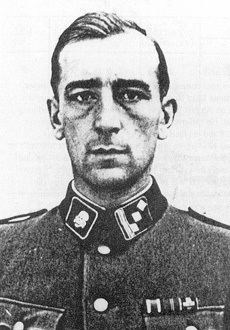Allegiance Nazi Germany Battles/wars World War II Role SS officer Service/branch Waffen-SS | Years of service 1934–44 Name Siegfried Muller Battles and wars World War II | |
 | ||
Rank Sturmbannfuhrer (Major) Awards Knight's Cross of the Iron Cross
Iron Cross I Class
Iron Cross II Class
German Cross in Gold
Infantry Assault Badge in Bronze
Eastern Front Medal
Wound Badge
Close Combat Clasp in Bronze
Honour Roll Clasp of the Army Died April 7, 1974, Hamburg, Germany Unit 3rd SS Panzer Division Totenkopf, 12th SS Panzer Division Hitlerjugend | ||
Siegfried Muller (18 October 1914 – 7 April 1974) was a Sturmbannfuhrer (major) in the Waffen-SS during World War II. He was awarded the Knight's Cross of the Iron Cross to recognize extreme battlefield bravery or successful military leadership by Nazi Germany during World War II.
Contents
Early life
Siegfried Muller was born on 18 October 1914, in Krefeld on the Rhine in Germany to Paul and Wilhelmine Muller. His father was killed in 1916, fighting in World War I before Siegfried had turned two years old. In 1920 his mother remarried. He graduated middle school in 1933, and started as an apprentice with an architect's firm in Essen. In 1935, Muller ended his apprenticeship and joined the German army.
When he was 21, he was posted to the 1st Company, 1st Pioneer (Engineer) Battalion stationed in Konigsberg and received his basic training. He was later selected to become an officer and commissioned with the rank of lieutenant in the Reserve in January in 1938. He was then given command of 3rd (mot) Company, 1st Pioneer Battalion. As Muller had volunteered to join the SS in April 1934 (SS service number 230815), he transferred to the active list in November, 1938, and was posted to the SS Totenkopf Standarte Brandenberg with the rank of untersturmfuhrer (second lieutenant).
World War II
Muller was promoted to Obersturmfuhrer in January, 1940. He was awarded his first combat decorations during the Battle of France, the Iron Cross II class in May and the I class in June, 1940. His next promotion to Hauptsturmfuhrer was in April, 1941, just before he took part in Operation Barbarossa, the invasion of the Soviet Union. He was awarded the Eastern Front Medal followed by the German Cross in Gold in October, 1942, and the Infantry Assault Badge in December, 1942.
Siegfried Muller was awarded the Knight's Cross in December, 1944. By now he had been promoted to Sturmbannfuhrer and had been transferred to the 12th SS Panzer Division Hitlerjugend and was in command of the 25th SS Panzergrenadier Regiment.
After the 227th Grenadier Division was unsuccessful in forcing a breakthrough of the American positions to the west of Hollerath on 16 December 1944, the next day the 25th SS Panzergrenadier Regiment was tasked to force a breakthrough towards Krinkelt. The US 2nd Infantry Division had moved forward into the area of Rocherath and Krinkelt. In two days of hard fighting in villages and forests the 25th SS Panzergrenadier succeeded in breaking through the US 99th Infantry Division's positions to retake Rocherath which was defended by the US 2nd Infantry Division, capturing over 450 prisoners of war.
Post war
Muller survived the war and returned to being an architect living under the assumed name of Heuser (his mother's maiden name). He died in Hamburg on 7 April 1974.
